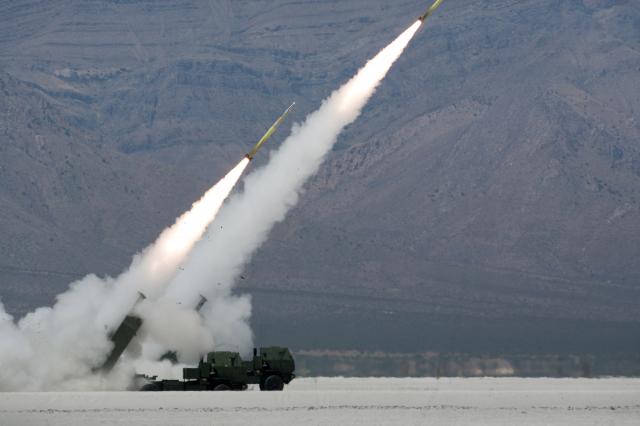Dust flew on White Sands Missile Range during a test of an improved missile launch system conducted April 27, 2011, at White Sands Space Harbor, N.M.
Members of the Precision Fires Rocket and Missile System Project Office test fired an upgraded version of the High Mobility Artillery Rocket System, or HIMARS. The test focused on new navigation and targeting equipment installed on the HIMARS system intended to enhance the system’s ability to rapidly deploy from an aircraft and fire.
To conduct the test, two HIMARS vehicles were loaded onto a C-17 cargo plane, with a third loaded onto a C-130 cargo plane. The planes then flew to White Sands Missile Ranger, or WSMR, and landed at Space Harbor where the HIMARS vehicles were quickly unloaded and their missiles launched.
“What this capability allows is proofing out the concept of allowing a system like the HIMARS to fly on a C-130 or a C-17 and come in and execute a target set and load back up and fly back to home station or a forward operating base,” said Lt. Col. Gregory Paul, product manager for Field Artillery Launchers, Precision Fires Rocket and Missile Systems Project Office.
The test was conducted in two parts, the first part being the pair of launchers deploying from the C-17. After firing, the pair of launchers were loaded back onto the C-17 and flown away to clear the area for the C-130 to land and repeat the process with the single launcher it had on board.
The HIMARS is a truck mounted version of the Multiple Launch Rocket System, or MLRS. Able to carry all of the same rocket and missile payloads as the tracked vehicle based MLRS, the HIMARS benefits from additional mobility allowing it to keep up with lighter units than the MLRS
“One of the things the Army learned long ago was tracks go with tracks and wheels go with wheels. The HIMARS on a five ton truck derivative is more aligned with our light forces,” Paul said.
The test leveraged the HIMARS’ lightweight and high mobility and coupled it with the ubiquitous nature of the C-17 and C-130, two of the Air Force’s most common and versatile transport aircraft.
“What it does is, it merges existing capabilities between the Army and the Air force,” said Paul.
This test was the capstone event for the project, and represents years of work by both the servicemembers and civilians working on improving the system.
“It’s a culmination of many years of work of the product office, the end user community at Fort Sill Oklahoma, and many of our teammates,” Paul said.
Since the upgraded navigation and targeting systems are so vital to mission of providing accurate artillery missile and rocket strikes, extensive work had to be done to ensure the systems were up to the challenge.
“We’ve gone through quite a bit of testing. The genesis of this project was almost five years ago. It’s something that’s been on the drawing board that we’ve worked with the precision fires project office for quite some time,” said Matthew Berger director of MLRS launchers for Lockheed Martin Missiles and Fire Control.
White Sands Missile Range was chosen as the location test for several reasons.
“Space Harbor with the Shuttle runway afforded us that ability to do this joint operation with the C-17 and C-130 that could accommodate us and still have the range (safety) fan so we could fired the guided MLRS unitary rounds,” Paul said.
Originally constructed for use as an alternate landing site for the retiring Space Shuttle, WSMR’s Space Harbor features a large runway perfect for landing large aircraft on. Located in the heart of the missile range, it was also the perfect location for a test like this one because it provided not only a place for the transport aircraft to land, but also a secure location, military controlled airspace, and direct access to impact areas.
These features came together to provide the project with a perfect location that would allow the complex test to be conducted safely.
“When the customer was considering other installations for their test site, we marketed the White Sands Space Harbor to them as a viable facility for the HIMARS C-17/C-130 Quick Strike Joint Operational Test,” said Christi Griego, WMSR’s HIMARS test officer.
The end result of the work between WSMR, the Rocket and Missile System Project Office, and the Air force was the completion of a test and the collection of valuable data to be used in evaluation of the system.
“We have a long history with (WSMR). It’s safe. It’s done professionally, and we get the data we need to ensure that before we put something in the field its effective, suitable, survivable and safe. That it’s truly proved out before we put it in Solders hands,” Paul said.
The test’s complexity and many moving parts, and the ability of the range to cater to those requirements added an additional capability to the range. Test officials now hope that as a result of this test, other activities with similar requirements will be conducted in the future.
“The successful planning, coordination, and conduct of the mission, by the HIMARS (WSMR) Test Office and Project Support, gave WSMR another capability by showing the test community that we can support different kinds of tests, as well as be a landing site for Army and Air Force missions,” Griego said.











